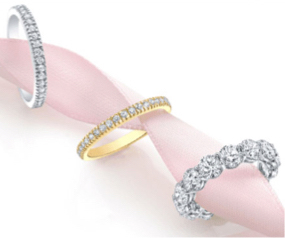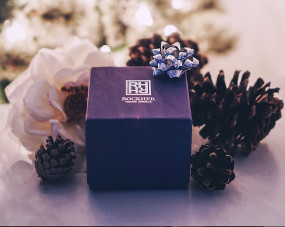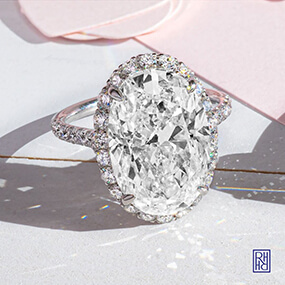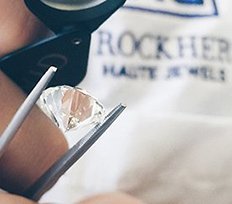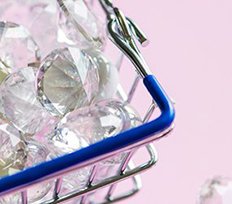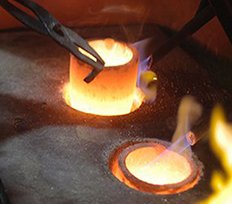Diamonds in the near-colorless part of the D-to-Z diamond color scale, are in the Goldilocks zone of diamond color: not too expensive like D, E & F colorless diamonds, but not noticeably off-white like K,L & M faint color diamonds. The value that near-colorless diamonds represent is just right.
Near-colorless diamonds are the biggest color range, with G, H, I and J-color grades all included in the category. There’s a big difference in price between G-color diamonds and J-color diamonds. So which of the near colorless grades are right for you and your engagement ring?
For most people, H is the best balance between beauty and value. But there’s a case to be made for I-color diamonds too.
Although the I-color grade is near the center of the near-colorless range, in our experience, it is the highest diamond color grade that most people notice isn’t really colorless. I color diamonds have a slightly warmer white color with a hint of yellow or brown.
Is that necessarily a negative thing? It depends on your expectations. Is your engagement ring setting platinum or white gold? If you really want your diamond to be colorless, upgrade to an H color. Are you choosing yellow or rose gold for your engagement ring setting? Your diamond will look whiter in contrast to the warm tone of those metals so an I-color diamond is a compromise you won’t regret making.
Here’s why. Gemological laboratories grade diamonds upside down so that the body color of the gem is visible to the grader’s eye without the distraction of brilliance, scintillation, and dispersion.
In the real world, those distractions dazzle the eye with brilliance. No one really buys a diamond for its absence of color, they buy diamonds because of the way they handle light.
Even for professionals, drawing the lines between diamond color grades is often difficult. To make it easier, every diamond’s color is evaluated in comparison to other diamonds with known grades called a diamond master set. That’s the only way to see the slight differences in color or absence of color that characterizes the color ranges that make up each of the GIA diamond color grades.
What does I color really mean? It means that this diamond, when placed upside down next to a diamond master set, can be seen by a trained professional to have slightly more color than an H color but slightly less than a J color diamond. The slight differences in color can only be seen consistently in comparison, face down, in a controlled environment.
The lines between grades are somewhat arbitrary: color in diamonds is a smooth continuum of increasing tints. Grades break that gradient into distinct steps: there will always be diamonds that sit on the line. That is why GIA created grades that are so precise: they wanted to minimize the financial difference between two diamonds that are very similar in color but fall on either side of a boundary between grades.
In practice, that means that it’s very difficult to tell the difference between an H-color and an I-color, especially in the face up position, even if you are comparing them side-by-side.
Will you be able to tell that your diamond is an I-color when you wear it in an engagement ring? Diamond professionals will be able to see that your diamond is not quite colorless but won’t really be able to tell its exact color grade. That’s why labs only grade loose diamonds.
Your friends and family will probably pay much more attention to how big the diamond is than the color grade. No one will ask to see your grading report. Investing in a better color grade doesn’t have much of a reward.
An I-color diamond will still look almost colorless even in an engagement ring that’s platinum or another white metal like palladium or white gold. And it will look particularly bright in a yellow or rose gold engagement ring.
If your budget is limited, it’s much better to invest in an excellent diamond cut that will give your diamond brilliance and scintillation than to buy a diamond that isn’t well cut but has a better color grade. Choosing an I-color gives you a white diamond at a relatively affordable price. It’s an especially good tradeoff if you are planning to set your diamond in yellow or rose gold.
WHAT ROSI RECOMMENDS
Generally ROSI recommends an H-color as the best balance between beauty and value. But I-color diamonds are a very good option, especially for yellow and rose gold engagement rings. I-color diamonds will look brightest in round brilliant diamonds and other well-cut brilliant diamond shapes like ovals, cushions, and princess cuts in sizes up to about one-carat. You may want to upgrade to a G or H color for emerald and Asscher cut diamonds, which have larger facets that make it easier to see slight tints of color, pointed shapes like marquise and pears, which will show more color in the corners, and diamonds that are two carats and up. ROSI will automatically take diamond shape and size into account when evaluating diamond color and finding you the best value diamond for your budget.
How does ROSI know diamonds so well? We trained her with dozens of professional diamond buyers. We asked them which diamonds among thousands they would buy for themselves or their daughters. ROSI calculated how they balanced more than 30 individual quality factors and applies those lessons to sift through all the grading reports of all the diamonds available on the market to pick the best combination of quality and value. With ROSI, you’ll find that brilliant needle in the haystack every time.


